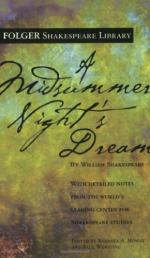|
This section contains 4,735 words (approx. 16 pages at 300 words per page) |

|
SOURCE: “A Midsummer Night's Dream: A Gentle Concord to the Oedipal Problem,” in American Imago, Vol. 40, No. 4, Winter, 1983, pp. 355-69.
In the following essay, Hartman identifies oedipal conflict originating in the incestuous desires of Egeus as well as Titania, and maintains that the play optimistically presents the resolution of such conflict within the confines of the “dream.”
A Midsummer Night's Dream was written in honor of the marriage between Countess Southampton and Sir Thomas Heneage, the Queen's advisor. It is thought the Countess married her knight for political protection when her son committed the dangerous faux pas of promising to marry powerful Lord Burghley's granddaughter and, four years later, obdurately refused the match. Young Southampton's peculiar reluctance to wed a comely, well-titled woman culminated in a well-documented scandal. Shakespeare, then the Southamptons' family poet, gamely transformed Heneage into politic, dignified Theseus, wizarded the headstrong countess into Hippolyta and...
|
This section contains 4,735 words (approx. 16 pages at 300 words per page) |

|


